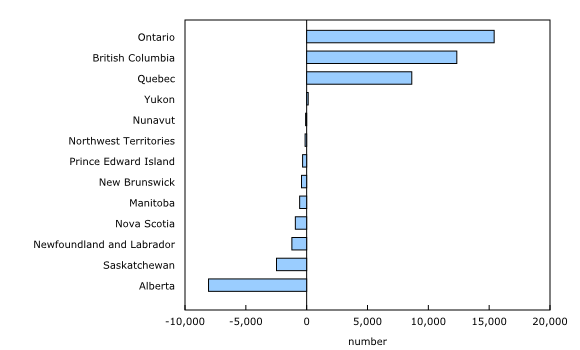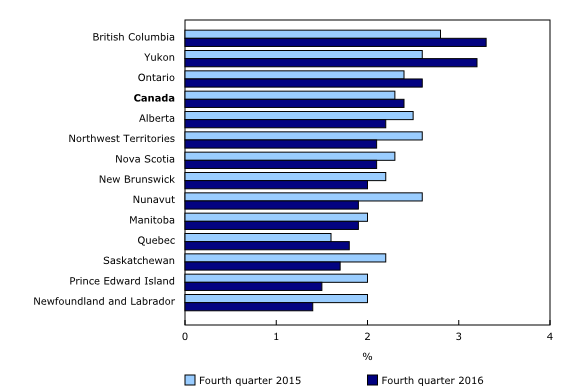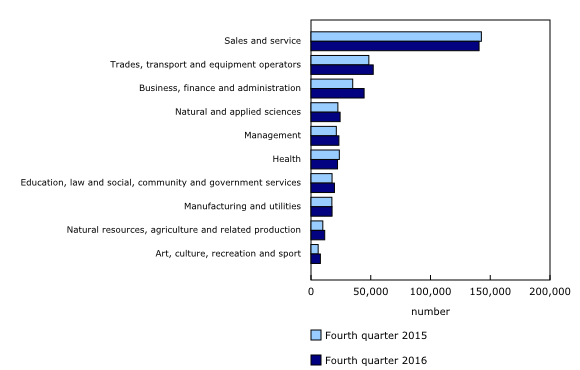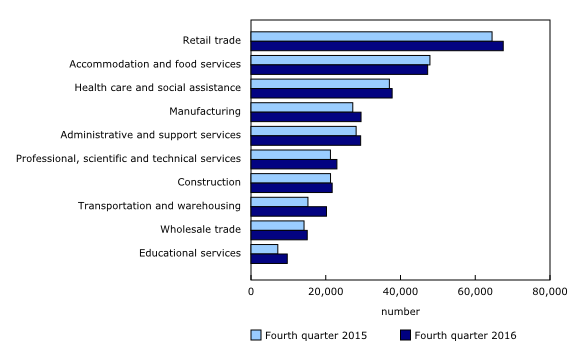Job vacancies, fourth quarter 2016
Archived Content
Information identified as archived is provided for reference, research or recordkeeping purposes. It is not subject to the Government of Canada Web Standards and has not been altered or updated since it was archived. Please "contact us" to request a format other than those available.
Released: 2017-04-13
Job vacancies rose 6.3% from the fourth quarter of 2015 to 375,000 in the fourth quarter, following little year-over-year change in the third quarter. Meanwhile, the job vacancy rate increased 0.1 percentage points to 2.4%.
Compared with the third quarter of 2016, the number of job vacancies (unadjusted for seasonality) fell by 6.6% in Canada, while the job vacancy rate decreased by 0.1 percentage points. These quarter-to-quarter declines may reflect typical seasonal recruitment patterns, as job vacancies also decreased (-12.0%) between the same quarters in 2015.
The job vacancy rate refers to the share of jobs that are unfilled out of all available payroll jobs. It represents the number of job vacancies expressed as a percentage of labour demand; that is, the sum of all occupied and vacant jobs.
Provincial overview
British Columbia, Quebec and Ontario had more job vacancies between the fourth quarter of 2015 and the fourth quarter of 2016. These provinces also had the largest growth in payroll employment among all the provinces. Meanwhile, job vacancies fell in five provinces and were little changed in New Brunswick and Manitoba.
Job vacancies in British Columbia were up 12,000 (+21.0%) in the fourth quarter compared with the same quarter a year earlier. The job vacancy rate rose 0.5 percentage points to 3.3%, the largest increase among the provinces. Increases were focused in the economic regions of Lower Mainland–Southwest and Vancouver Island and Coast.
Since the third quarter of 2015, British Columbia has had the highest job vacancy rate among the provinces. Higher job vacancy rates are often associated with periods of economic growth. Other indicators, such as the employment growth and the unemployment-to-vacancies ratio, point to a strong economy and a tighter labour market for the province. Generally, labour markets are tighter when the number of people looking for work is low relative to the number of job vacancies. Over the same period, the Survey of Employment, Payrolls and Hours (SEPH) showed that British Columbia had the strongest employment growth and the lowest unemployment-to-job vacancies ratio among the provinces.
In Quebec, job vacancies rose by 8,600 (+16.2%) in the fourth quarter. The job vacancy rate in the province increased 0.2 percentage points to 1.8%. Vacancies rose in most economic regions, although they were little changed in Montréal.
Job vacancies in Ontario rose by 15,000 (+10.6%) in the fourth quarter compared with the same quarter one year earlier and the job vacancy rate increased from 2.4% to 2.6%. The economic region of Toronto accounted for just over 83% of the net rise in provincial job vacancies, while accounting for about half of payroll employment in Ontario in the fourth quarter. Notable increases in job vacancies were also observed in Ottawa (+16.4%) and Kitchener–Waterloo–Barrie (+11.4%).
The number of job vacancies in Alberta fell by 8,100 (-16.0%) in the fourth quarter compared with the fourth quarter of 2015, the largest year-over-year decrease among the provinces. At the same time, the job vacancy rate declined from 2.5% to 2.2%. Wood-Buffalo-Cold Lake (+400) was the sole economic region in Alberta to report more vacancies in the fourth quarter compared with the same quarter one year earlier. At the same time, the job vacancy rate in this economic region increased 0.8 percentage points to 2.4%, as employment fell by 17.5%.
The number of job vacancies and the job vacancy rate in Alberta have been declining on a year-over-year basis since the start of the series. However, the 8,100 job vacancy decline in the fourth quarter was the smallest to date, which may reflect a slowing of this trend. Recent employment data from the Labour Force Survey point to modest improvements in labour market conditions in Alberta. Following significant declines from the fall of 2015 to the summer of 2016, total employment in the province stabilized in the second half of 2016.
Despite the overall decline in Alberta, job vacancies were up in several sectors, including administrative and support services (+1,100) as well as mining, quarrying, and oil and gas extraction (+500).
Job vacancies by occupation
Nationally, the number of job vacancies increased in most broad occupational groups on a year-over-year basis. Close to 60% of the net national increase was concentrated in two occupational groups. Vacancies in business, finance and administration occupations were up 9,500, particularly in mail and message distribution occupations (+5,300) and general office workers (+2,300). In addition, vacancies increased notably in trades, transport and equipment operators and related occupations (+3,700), mainly for longshore workers and material handlers (+1,300) and carpenters and cabinetmakers (+600).
Provincial job vacancies by occupation
In Ontario, the rise in job vacancies in the fourth quarter was spread across most broad occupational groups. The largest increases were in sales and service occupations (+5,100); business, finance and administration occupations (+4,400); as well as trades, transport and equipment operators (+3,800). The gain in vacancies in trades, transport and equipment operators in the province accounted for most of the national change for this occupation. In the fourth quarter, the lone broad occupational group to have fewer job vacancies in Ontario was manufacturing and utilities (-1,400).
In British Columbia, job vacancies rose in most broad occupational groups. There were notable increases in business, finance and administration occupations (+2,400) and trades, transport and equipment operators (+1,700).
Job vacancies in Quebec rose the most in occupations related to manufacturing and utilities (+1,800); business, finance and administration occupations (+1,700); as well as those in trades, transport and equipment operators (+1,700). Overall, temporary positions accounted for about 45% of the rise in vacancies in Quebec, compared with about 25% in Ontario and 30% in British Columbia.
Close to 90% of the decline in vacancies in Alberta in the fourth quarter was concentrated in sales and service occupations. For the province as a whole, almost 60% of the decrease in job vacancies was in full-time positions.
Job vacancy rate by industrial sector
Nationally, the number of job vacancies in the fourth quarter increased in 4 of the 10 largest industrial sectors, led by transportation and warehousing (+5,000).
Job vacancies grew by 1,200 (+79.8%) in mining, quarrying, and oil and gas extraction in the fourth quarter, the first year-over-year increase in vacancies for the sector since the start of the series. About 45% of the increase in this sector was the result of gains in Alberta. Nationally, the job vacancy rate for the sector increased by 0.7 percentage points to 1.4%.
Job vacancies and offered hourly wage
Nationally, the average offered hourly wage for job vacancies was $19.70 in the fourth quarter, up $0.75 or 4.0% compared with the same quarter one year earlier.
Changes in the average offered hourly wage can reflect a variety of factors, including wage growth and changes in the composition of job vacancies by occupation, sector and between part- and full-time positions.
Increases in the offered wage were spread across most broad occupational groups, with management (+7.4%); education, law and social, community and government services (+7.1%); and natural resources, agriculture and related production (+6.0%) occupations reporting the largest growth in the quarter.
An increase in the number of job vacancies for higher-paying occupations, such as mine service workers and operators in oil and gas drilling as well as contractors and supervisors in mining, oil and gas, contributed to the rise in the offered wage for natural resources, agriculture and related production occupations.

In celebration of the country's 150th birthday, Statistics Canada is presenting snapshots from our rich statistical history.
A look back at job vacancies by occupation in the 1960s
For part of 1965 and 1966, Statistics Canada published monthly job vacancy statistics based on administrative records from the National Employment Service (NES). The NES, managed by the federal Department of Labour and, later, the Department of Manpower and Immigration, provided a listing of vacancies by employers. The data related only to vacancies reported to the NES.
In April 1966, Statistics Canada reported 67,090 job vacancies. Job vacancy statistics at that time were classified by a number of characteristics, including occupation and sex.
Typically, job vacancies offered by sex reflected the opportunities that were commonly available to women and men at the time.
For example, in April 1966, Statistics Canada reported 6,907 vacancies for domestic and personal service workers. Just over 90% of these jobs were specifically offered to women.
Conversely, there were 2,120 job vacancies for loggers and bushmen, none of which were open to women. While there were 841 vacancies for engineers, 5 of these were open to women.
Source: Unfilled Vacancies and Unplaced Applicants, Dominion Bureau of Statistics, April 1966.
Change in the number of job vacancies, third quarter to fourth quarter, 2015 and 2016, Canada
Note to readers
The Job Vacancy and Wage Survey (JVWS) is a quarterly survey that provides comprehensive information on job vacancies by industrial sector, detailed occupation and skill level sought for Canada, the provinces, territories and economic regions.
In July, the JVWS will be publishing historically revised estimates with the data release for the first quarter of 2017. These estimates will be calibrated on the revised employment totals from the Survey of Employment, Payrolls and Hours released on March 31.
JVWS data are not seasonally adjusted. Therefore, quarter-to-quarter comparisons should be interpreted with caution as they may reflect seasonal movements.
This analysis focuses on differences between estimates that are statistically significant at the 68% confidence level.
Annual wage and employment data by occupation started being collected for the wage component of the survey in January 2016. The release of these data is scheduled for June 2017.
Summary statistics related to the job vacancy time series from the Survey of Employment, Payrolls and Hours are available in CANSIM.
Occupations are classified according to the National Occupational Classification (NOC) 2011. The NOC is a four-tiered hierarchical structure of occupational groups with successive levels of disaggregation. The structure is as follows: 1) 10 broad occupational categories, also referred to as one-digit NOC; 2) 40 major groups, also referred to as two-digit NOC; 3) 140 minor groups, also referred to as three-digit NOC; and 4) 500 unit groups, also referred to as four-digit NOC.
Industrial sectors are classified according to the North American Industry Classification System (NAICS) 2012. The NAICS has 20 industrial sectors at the two-digit level.
Data quality of the Job Vacancy and Wage Survey
The target population of the survey includes all business locations in Canada, with the exclusion of those primarily involved in religious organizations and private households. While federal, provincial and territorial administrations are also excluded from the survey for now, they will be phased in later.
Next release
Job vacancy data from the JVWS for the first quarter of 2017 will be released in July.
Products
More information about the concepts and use of data from the Job Vacancy and Wage Survey is available online in the Guide to the Job Vacancy and Wage Survey (75-514-G).
Contact information
For more information, contact us (toll-free 1-800-263-1136; 514-283-8300; STATCAN.infostats-infostats.STATCAN@canada.ca).
To enquire about the concepts, methods or data quality of this release, contact Myriam Hazel (613-219-4345; myriam.hazel@canada.ca), Labour Statistics Division.
- Date modified:





